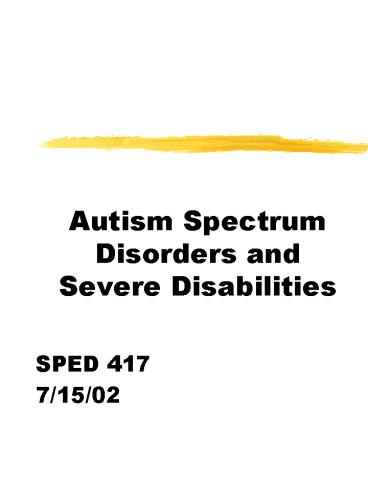Autism Spectrum Disorders and Severe Disabilities - PowerPoint PPT Presentation
1 / 16
Title:
Autism Spectrum Disorders and Severe Disabilities
Description:
Autism Spectrum Disorders (ASDs) and Pervasive Developmental Disorders (PDDs): Characteristics ... Period of using echolalia. Delayed. Immediate ... – PowerPoint PPT presentation
Number of Views:52
Avg rating:3.0/5.0
Title: Autism Spectrum Disorders and Severe Disabilities
1
Autism Spectrum Disorders and Severe Disabilities
- SPED 417
- 7/15/02
2
Wetherby Prizant, 2000
3
Wetherby Prizant, 2000
4
Autism Spectrum Disorders (ASDs) and Pervasive
Developmental Disorders (PDDs) Characteristics
- Neurodevelopmental disorders that have 3 core
features - Impairments in social interaction
- Impairments in verbal and nonverbal communication
- Restrictive and repetitive patterns of behavior
- Joint attention appears to be a fundamental
component of etiology of autism - Impairments in the capacity for symbol use
- Approximately 50 of individuals with autism do
not develop functional speech
5
Autism Spectrum Disorders (ASDs) and Pervasive
Developmental Disorders (PDDs) Characteristics
- Use of primitive presymbolic gestures lack of
conventional gestures such as pointing. - Period of using echolalia
- Delayed
- Immediate
- May be single word or phrase which may serve as a
label for a situation or event. Learn meaning of
phrases by finding out how they work. - Gestalt processing
- For individuals with speech a disturbance of the
pragmatics of language use is prominent - Cognitive impairment
- About 50 of individuals with autism function in
the same IQ range as individuals with mental
retardation. - 25 develop communicative language before the age
of 5 years have less severe disabilities. - 25 have typical intelligence function
independently (Beukelman Mirenda, 1998).
6
Services A Major Issue
- Incidence
- Incidence of autism has increased dramatically
- Initially thought occur in approximately 5-15 per
10,000 births. - Now thought to occur at a rate of 1 in 1000
(Mundy Stella, 2000) possibly 1 in 500
depending on diagnostic criteria. - Illinois reported increase from 317 new cases in
1991 to 2,305 in 1997 (Fienberg Vacca, 2000).
7
Services A Major Issue
- No Consensus on Etiology
- Genetic predisposition
- Various combination of affected genes however
what combinations trigger the condition is
unknown. - Neurobiological/chemical
- Difference in brain chemistry
- Shortened brain stem as well as other
abnormalities in brain structures. - MMR Vaccine
- Environmental toxins
- Diet/nutrition
8
Services A Major Issue
- No Consensus on Intervention
- Lovaas
- Applied Behavior Analysis
- Discrete Trial
- TEACCH
- Treatment Education of Autistic Related
Communication Handicapped Children
http//www.teacch.com/ - PECS
- Picture Exchange Communication System
http//www.pecs.com/index.html - Greenspan
- Floor Time
- Sensory Integration
- New emphasis on integrating approaches
9
Services A Major Issue
- Age of Diagnosis
- Services provided prior up to age 3 may not be
provided with special education. - e.g., Lovaas (40,000/year)
- Litigation
- Family -Centered Paradigm
- Access to information
- Increase in due process hearings
- Policy Implications
- How to plan programs
- IDEA ignores cost issues for specific children
(Fienberg Vacca, 2000). - What is appropriate?
10
Severe and Multiple Disabilities
- IDEA Sec.300.7
- Multiple Disabilities
- Concomitant impairments (such as mental
retardation-blindness, mental retardation-orthoped
ic impairment, etc.), the combination of which
causes such severe educational needs that they
cannot be accommodated in special education
programs solely for one of the impairments. - Curriculum
- What to teach
- Goals
- OUTCOMES
- Ecological Inventory
11
Severe DisabilitiesTop Down Approach
DOMAINS
ENVIRONMENTS
SUBENVIRONMENTS
ACTIVITIES
SKILLS
INSTRUCTIONAL PROGRAMS
See domestic domain handout example
12
Severe Disabilities Curriculum
- Ecological Inventory Environments
- school
- home
- community
- work
- OUTCOMES Access To General Education Curriculum
- SAME
- ADAPTED/SUPPLEMENTED
- DIFFERENT
- see outcome handout
- Assessment
- Curriculum based assessment
- Illinois Alternative Assessment
- Student with severe disabilities are not likely
to participate in ISAT - Based on Illinois Learning Standards
- http//www.measuredprogress.org/ProductsandService
s/SpecialEducation/Illinois/Illinois.html
13
Severe Disabilities
- Instructional Program Objectives
- Selection
- needs
- priorities
- functional and meaningful outcomes
- appropriate for age
- Quality
- Observable
- Appropriate condition statements
- Appropriate criterion statements
- allow for assessing/instructing in environment
where skill would typically be performed. - IEP activity
- Case study activity
14
Case StudyMarc
- Marc is a 14 year old student who is ambulatory
but has physical limitations including poor
muscle control in upper and lower extremities as
well as poor fine motor skills. He has very
limited speech using 3-5 words to request
favorite snacks and enjoys watching T.V. and
listening to music. His family would like him to
become as independent as possible and are hoping
for placement in a group home by age 21 however
he is dependent on his family for all daily
living requirements. The group home requires
residents to maintain their rooms, have good
mealtime and grooming and hygiene skills, and
participate in community leisure activities. - Identify an outcome
- Write a goal
- Write two objectives for this goal.
15
Severe Disabilities Curriculum Issues
- IDEA 97 Access to the General Curriculum
- participation
- progress
- align IEP goals with general curriculum standards
- statewide assessment
- improve outcomes of students with disabilities
- Effect of district/state policy for teachers and
students with severe disabilities - IEP Assessment
16
Severe Disabilities Transition
- IDEA 97
- Coordinated set of transition services at age 14
- Rehabilitation Act (1974)
- Students with severe disabilities entitled to
continuing services when they leave school - Supported employment
- Continued educational programs
- Educators Role
- work experience work related behaviors
- Work interests and preferences
- Supports to ensure success































